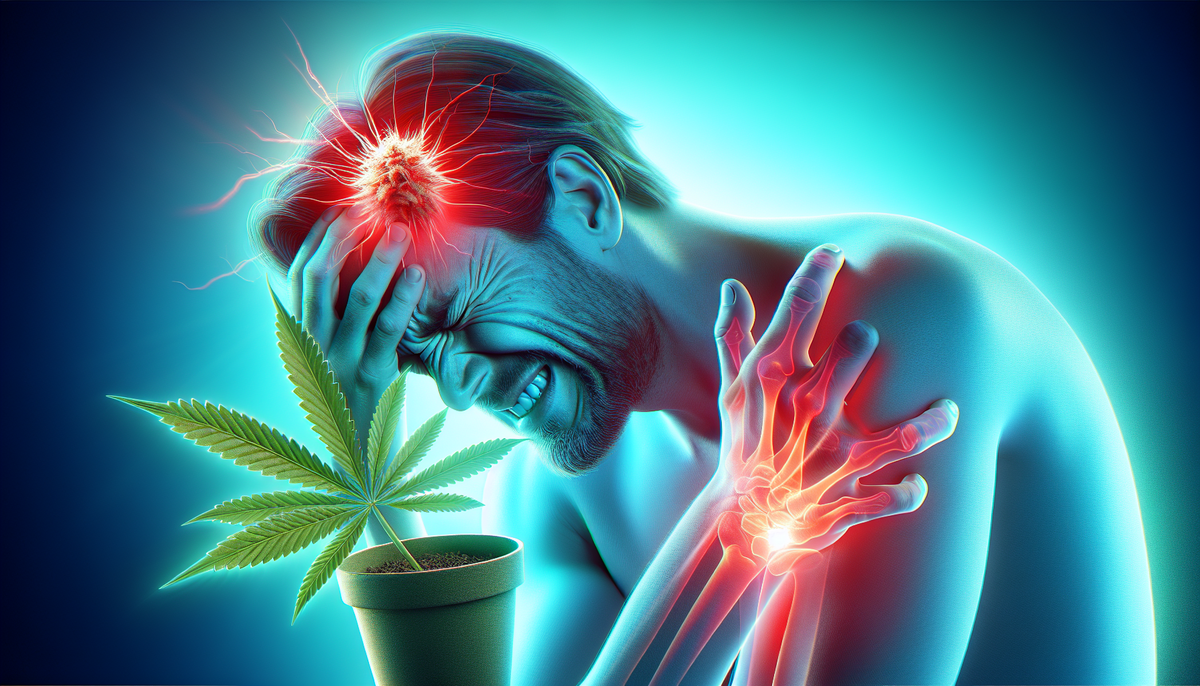Exploring the Effectiveness of CBD for Pain Relief
Written by: Daniel Fayad, Subject Matter Expert and Website President
Published: March 15, 2024; Last updated: April 6, 2024
- 1. Key Takeaways
- 2. CBD and Chronic Pain: A Promising Alternative
- 2.1 The Opioid Crisis and the Need for Alternatives
- 2.2 How CBD Works for Pain Relief
- 2.3 Current Market Trends in CBD for Pain Management
- 3. CBD’s Impact on Neuropathic Pain
- 3.1 Current Research Findings
- 3.2 Potential Benefits and Risks
- 3.3 Ideal Dosages and Administration Methods
- 4. CBD for Arthritis and Joint Pain
- 4.1 Anti-Inflammatory Properties
- 4.2 Human Trials and Results
- 4.3 Recommended Usage and Precautions
- 5. CBD’s Role in Multiple Sclerosis and Muscle Spasms
- 5.1 Studies Supporting CBD’s Effectiveness
- 5.2 Potential Side Effects and Interactions
- 5.3 Future Research Directions
- 6. Regulatory Landscape and Quality Control Issues
- 6.1 FDA Involvement and Oversight
- 6.2 Consumer Awareness and Education
- 6.3 Importance of Third-Party Testing
- 7. Navigating the CBD Market: Tips for Consumers
- 7.1 Understanding CBD Labels
- 7.2 Identifying Reputable Brands
- 7.3 Potential Drug Interactions and Side Effects
- 8. Summary
- 9. Frequently Asked Questions
- 9.1 Which form of CBD is best for pain?
- 9.2 What is the best time of day to take CBD for pain?
- 9.3 What drugs should not be taken with CBD?
- 9.4 Does CBD help with pain and arthritis?
- 9.5 What cannabis product is good for joint pain?
- 10. References
As we navigate the 21st century, the search for effective, non-addictive alternatives for managing chronic pain is at the forefront of medical research. Amidst the sea of possibilities, one compound is catching the attention of researchers, physicians, and patients alike: Cannabidiol (CBD). Derived from hemp, a cousin of the marijuana plant, CBD is being investigated for its potential role in pain relief, without the risk of addiction associated with opioids. Today, we embark on an exploratory journey into the potential of CBD for different types of pain, the regulatory landscape surrounding its use, and tips for consumers venturing into the rapidly expanding CBD and pain relief market.
Key Takeaways
CBD is being explored as a non-addictive alternative to opioids for chronic pain relief, by potentially influencing the body’s endocannabinoid, inflammatory, and nociceptive systems.
Research suggests that CBD may be beneficial for neuropathic pain, arthritis, and muscle spasms related to multiple sclerosis, but more human trials are needed to establish efficacy and ideal dosages.
The regulatory landscape is evolving with the FDA overseeing the safety and quality standards of CBD products, emphasizing consumer education and the importance of third-party testing.
CBD and Chronic Pain: A Promising Alternative

CBD’s potential to revolutionize chronic pain management is becoming increasingly recognized, with many turning to CBD for chronic pain as a non-addictive alternative. Interest has been piqued in this option because of its potential to influence endocannabinoid, inflammatory, and nociceptive systems, without the opioid-associated dependency risks.
CBD oil, extracted from the cannabis plant, is utilized for its pain-relieving properties among others, making it a popular choice for medical cannabis users.
The Opioid Crisis and the Need for Alternatives
Given the opioid crisis, there is a pressing need for safer alternatives for pain relief. The opioid-involved overdose fatalities have been on the rise in the United States, notably increasing in 2020 and 2021. This has spurred interest in alternative treatments such as CBD and medical marijuana, which may offer respite from pain-related behaviors without the risks associated with opioids.
How CBD Works for Pain Relief
The mechanism by which CBD relieves pain involves our body’s endocannabinoid system. CBD’s interaction with the complex network of cannabinoid receptors, which regulate pain perception, potentially provides pain relief and assists with various conditions. This interaction, particularly with cannabinoid receptors CB1 and CB2, influences pain mechanisms in the body, including inflammatory and neuropathic pain. ²
Unlike THC, another compound found in cannabis that primarily attaches to the cannabinoid receptor 1 (CB1), CBD attaches to these receptors differently.
Current Market Trends in CBD for Pain Management
Aligning with the increasing recognition of CBD’s potential for pain management, the CBD market is experiencing remarkable growth. Valued at $5 billion in 2021, it’s expected to reach an estimated market size of $22.05 billion by 2030. Among the various products, CBD oil has emerged as the leading choice for effectively addressing chronic pain, accounting for more than 30% of the market share.
CBD’s Impact on Neuropathic Pain

Delving deeper into CBD’s potential applications, we will examine its impact on a specific type of pain – neuropathic pain. Neuropathic pain is characterized by:
Tingling
Numbness
Muscle weakness
Sharp, shooting, burning, or stabbing sensations
Studies suggest that cannabis and cannabinoid products, including CBD and THC: CBD extracts, may offer relief for cancer pain and potentially reduce pain-related behaviours, as well as relieve chronic pain. Additionally, transdermal cannabidiol reduces inflammation, further contributing to pain relief. ¹
Current Research Findings
Presently, research indicates that CBD may help reduce symptoms of chronic neuropathic pain and may even offer a protective effect. For instance, a 2017 review showed CBD’s effectiveness in managing chronic neuropathic pain in humans, while a systematic review of other research revealed that a THC: CBD (1:1) extract exhibited analgesic properties.
Potential Benefits and Risks
Despite CBD’s potential advantages, like alleviating neuropathic pain, it’s important to consider potential risks. These may include increased cardiac rate, concentration deficit, and drowsiness, among others.
It’s crucial to evaluate CBD’s potential health benefits and drawbacks as research progresses.
Ideal Dosages and Administration Methods
During our exploration of CBD’s potential in managing neuropathic pain, it’s vital to determine the ideal dosage and administration method. The recommended dosage of CBD for neuropathic pain is typically around 20 to 30 milligrams per day, with some studies indicating the use of higher doses up to 800 milligrams per day. However, more research is needed to confirm these recommendations.
CBD for Arthritis and Joint Pain

Arthritis and joint pain, common ailments affecting millions worldwide, may find a solution in CBD. Research suggests that CBD’s anti-inflammatory properties may have potential in managing arthritis and joint pain. However, as with its use in neuropathic pain, more human trials are needed to confirm CBD’s effectiveness in this area.
Anti-Inflammatory Properties
CBD’s anti-inflammatory effects have been substantiated in various studies, including animal and preclinical research. These studies have validated CBD’s ability to mitigate inflammation, as evidenced by its impact on immune cells in dogs and its anti-arthritic activity targeting synovial fibroblasts under inflammatory conditions.
Human Trials and Results
While animal and preclinical studies offer promising results, human trials are crucial for confirming CBD’s effectiveness in arthritis and joint pain management. Trials so far have shown that CBD can notably enhance pain relief during movement and at rest, as well as improve physical function in individuals suffering from rheumatoid arthritis and osteoarthritis-related knee pain.
Recommended Usage and Precautions
Considering the use of CBD for arthritis and joint pain requires taking certain precautions. These include:
Seeking advice from a healthcare professional
Being vigilant for potential adverse interactions with other medications
Initiating with a conservative dosage
CBD’s Role in Multiple Sclerosis and Muscle Spasms

CBD may also hold potential in treating multiple sclerosis (MS), a chronic disease affecting the nervous system. Studies suggest that CBD may help reduce muscle spasms and associated pain in multiple sclerosis, but more research is needed to confirm its effectiveness. ²
Studies Supporting CBD’s Effectiveness
Several studies suggest that CBD oil may be effective in treating muscle spasms and pain in multiple sclerosis patients. For example, research on Delta-9-tetrahydrocannabinol/cannabidiol (Sativex ®) for patients with moderate to severe spasticity has clinical data and evidence showing improvement in spasticity and pain for multiple sclerosis patients.
Potential Side Effects and Interactions
Like any other medication or treatment, when using CBD for multiple sclerosis, potential side effects and drug interactions should be taken into account. These may include:
Dry mouth
Diarrhea
Reduced appetite
Dizziness or lightheadedness
Nausea
Vomiting
Urinary tract infection
Fatigue
Drowsiness
Headache
Future Research Directions
Current research on CBD’s role in managing pain for multiple sclerosis patients is promising, yet inconclusive. Future research should focus on understanding CBD’s role in multiple sclerosis pain management.
An upcoming clinical trial is set to explore the effects of CBD and THC, both in combination and separately, on sleep and pain in individuals with multiple sclerosis.
Regulatory Landscape and Quality Control Issues

With more individuals opting for CBD as a pain relief solution, regulatory bodies are enhancing their efforts to ensure the safety and quality standards of CBD products. The FDA, for instance, has explicit regulations on marketing CBD products.
FDA Involvement and Oversight
The FDA plays a significant role in the oversight of CBD products. It has stated that marketing CBD by incorporating it into food or promoting it as a dietary supplement is prohibited by law. The FDA also takes enforcement actions against companies unlawfully selling CBD products.
Consumer Awareness and Education
An expanding CBD market necessitates the increasingly important role of consumer education. Consumers should be well-informed about:
The source of the product, whether it is derived from hemp or marijuana
The level of THC present
The importance of being cautious when combining CBD with herbs or dietary supplements.
Importance of Third-Party Testing
To ensure the quality and safety of CBD products, third-party testing is vital. It offers consumers transparency regarding the contents of the products and guarantees that the testing process remains unaffected by the manufacturer’s influence.
Navigating the CBD Market: Tips for Consumers
For consumers navigating the rapidly expanding CBD market, it’s crucial to understand labels, identify reputable brands, and be aware of potential drug interactions.
The following subsections will provide tips for navigating the CBD market.
Understanding CBD Labels
To make informed decisions about product quality and safety, understanding CBD labels is crucial. The term ‘full-spectrum’ on CBD product labels indicates the presence of various natural cannabis plant extracts, including up to 0.3% THC, while ‘CBD isolate’ denotes the purest form of CBD, with no other cannabis plant compounds included.
Identifying Reputable Brands
To ensure the purchase of safe and effective CBD products, consumers should identify reputable brands. Consumers can authenticate the credibility of a CBD brand by:
Conducting inspections
Checking for third-party lab testing and certificate of analysis
Looking for clear labeling and packaging
Examining the product’s label.
Potential Drug Interactions and Side Effects
Awareness of potential drug interactions and side effects is essential to safely use CBD. CBD has the potential to disrupt the efficacy of other drugs and medications, such as anti-epileptic drugs, antidepressants, and opioid analgesics, which may lead to alterations in medication levels in the bloodstream and subsequently influence their effectiveness.
Being mindful of any known side effects and potential interactions with other medications is essential.
Summary
To sum up, the potential of CBD as a non-addictive alternative for chronic pain management is just beginning to be explored. Whether it’s neuropathic pain, arthritis, joint pain, or muscle spasms associated with multiple sclerosis, CBD offers a promising alternative. However, as with any other treatment, it’s essential to be well-informed, consult healthcare professionals, and consider potential risks and side effects. As the CBD market continues to evolve, it’s our hope that the exploration of CBD’s potential will continue, ultimately leading to more effective pain management strategies for those who need it most.
Frequently Asked Questions
Which form of CBD is best for pain?
The best form of CBD for pain management depends on individual preferences and the severity of the pain. The effectiveness can vary from person to person.
What is the best time of day to take CBD for pain?
There is no specific best time to take CBD for pain, as it depends on individual preferences and the type of pain being addressed. Some may find it helpful in the morning for alertness or anxiety, while others may use it throughout the day for managing specific conditions.
What drugs should not be taken with CBD?
Do not take CBD with medications like antihistamines, benzodiazepines, antipsychotics, antidepressants, opioids, alcohol, and certain supplements, as it can increase drowsiness and other side effects. This can pose a risk to your health.
Does CBD help with pain and arthritis?
Yes, CBD can potentially help with pain and arthritis by reducing inflammation and managing discomfort, based on early studies, clinical trials, and research. Its effectiveness may vary for each individual.
What cannabis product is good for joint pain?
CBD products are a good choice for joint pain relief due to their anti-inflammatory properties and ability to reduce discomfort.
References
Villanueva, M. R. B., Joshaghani, N., Villa, N., Badla, O., Goit, R., Saddik, S. E., Dawood, S. N., Rabih, A. M., Niaj, A., Raman, A., Uprety, M., Calero, M., & Khan, S. (2022). Efficacy, Safety, and Regulation of Cannabidiol on Chronic Pain: A Systematic Review. Cureus, 14(7), e26913. https://doi.org/10.7759/cureus.26913
Atalay, S., Jarocka-Karpowicz, I., & Skrzydlewska, E. (2019). Antioxidative and Anti-Inflammatory Properties of Cannabidiol. Antioxidants (Basel, Switzerland), 9(1), 21. https://doi.org/10.3390/antiox9010021
WebMD. (n.d.-a). Cannabidiol (CBD) oil for pain and seizures shown. WebMD. https://www.webmd.com/pain-management/ss/slideshow-cbd-oil

Written by Daniel Fayad - Subject Matter Expert and Website President
Dan Fayad is a results-driven healthcare administration expert and content writer. With a Master of Health Administration from the University of Southern California, he’s carved a niche for himself in the dynamic world of healthcare and business development. Dan uses his experience to educate and empower people on their wellness journeys.
Join the CBDeals Club!
Get 10% off your first order and receive our best and exclusive promotions directly to your inbox!

